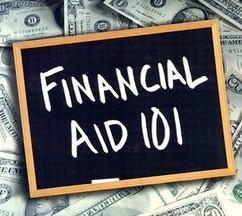
Financial aid is the vehicle many students use to finance their college educations. There are many forms of it which can make it confusing.
In truth the better you understand your financial aid package, the better you will be able to make good decisions about funding your education. The first step is to complete the FAFSA, any college financial aid forms, and possibly the PROFILE application. Without your application materials, your school will not be able to provide you with the best financial aid package available. Apply early to obtain the best financial aid package.
When you receive the letter detailing what your college can offer you, knowing a bit about each component of your package will help you make the best decisions. Remember, grants and scholarships don’t have to be paid back. Subsidized loans are less expensive to pay back and Unsubsidized loans are the most expensive to pay back. Here are some details about the most common forms of financial aid offered:
As you can see, there are a lot of options available to help you meet your educational expenses. It is always better if you can avoid taking loans but with the cost of education, that is not always an option. Remember to capitalize on CLEP tests, credits for A.P. tests, and early college options to help allay some of the expenses.
In truth the better you understand your financial aid package, the better you will be able to make good decisions about funding your education. The first step is to complete the FAFSA, any college financial aid forms, and possibly the PROFILE application. Without your application materials, your school will not be able to provide you with the best financial aid package available. Apply early to obtain the best financial aid package.
When you receive the letter detailing what your college can offer you, knowing a bit about each component of your package will help you make the best decisions. Remember, grants and scholarships don’t have to be paid back. Subsidized loans are less expensive to pay back and Unsubsidized loans are the most expensive to pay back. Here are some details about the most common forms of financial aid offered:
- Pell Grant - This is a needs-based grant that is awarded to students who have not yet earned a bachelor’s degree. The amount of money you receive will be based of your EFC (estimated family contribution) score. Although everything you read will say they are funded at a little over $5,000 per year it really isn’t true. The average Pell Grant award is currently $3551 per year because the program is very underfunded. So expect about $3,500 per year from this funding source. You do not pay this money back.
- SEOG – This is a needs-based grant that is awarded to the students with the lowest EFC (estimated family contribution) scores. This table from Forbes magazine will help you understand how a low EFC score will qualify you for a better financial aid package.In other words, it is awarded to the students who demonstrate the greatest need. If you have a low EFC and was not awarded this grant, you may want to contact your financial aid office to see if they can help you. The SEOG is one of those types of aid that you may miss out on if you don't get your application in early. You do not pay this money back.
- Federal Work Study – This is a program that gives you the opportunity to earn money during the school year. If you accept the award, you apply for jobs identified as work-study opportunities at your school and interview. If hired, you will receive a paycheck just like a regular job. The federal government typically pays half of your wage while the employer pays the other half. You do not pay this money back.
- Merit Scholarship – These are scholarships awarded to you based on your past academic performance. The scholarship may be good for one year only or for several years (based on you keeping your gpa above a certain cut-off score). Contact your high school or college counselor to get details on how to apply for these scholarships. You should start looking for Merit Scholarship opportunities the year before you graduate from high school. You do not pay this money back.
- General Scholarships – There are dozens of places to look for extra money on the internet. Many of these scholarships are small. However, the money can add up fairly quickly if you are vigilant and apply for as many scholarships as you can. Some of the more well known sites include Good Call, Student Scholarship Search, Fastweb, and Scholarship Points. Another great source is Cappex; a website that can help you with both college selection and scholarship opportunities. You do not pay this money back.
- Institutional Scholarships – Many colleges and universities receive large donations from college alumni that allow them to grant institutional scholarships to students. These scholarships are typically need-based. Contact the college you are attending to see if these types of scholarships might be available to you. You do not pay this money back.
- TEACH Grant – You can receive up to $4,000 per year to pay for your educational expenses if you are preparing to be a teacher. But this grant has a catch – if you don't teach in a high need field at a low income school for 4 years after you graduate, the grant turns into an unsubsidized loan that must be paid back. Your teaching must occur in the first 8 years after you graduate (and the big catch in this economy is that you actually have to be hired to do the teaching).
- Perkins Loan – This is a needs-based loan program funded by the federal government. The amount you can borrow depends on your year in college. During the first year you can borrow up to $3,500; in the second year of college you can borrow up to $4,500; and any year after that you can borrow up to $5,500. You will be charged 5% interest for the life of the loan. It’s called subsidized because the federal government pays the interest on the loan while you remain in school. This can save you a bundle. There is a 6 month grace period after you graduate or drop below half time school attendance before you have to start making payments. There are a few ways to have your Perkins Loan forgiven.
- Stafford Loan - This loan is backed by a bank and is an unsubsidized loan. You do not have to demonstrate need to qualify for it. It’s called unsubsidized because you are responsible for the interest for the life of the loan. The loan limits for these loans are tied to your subsidized loans. For example, if you're in your first year of school – your total loans cannot exceed $9,500 for the year.
- PLUS Loan – Did you know your parents may be eligible take out a low interest loan to help pay for your education? If you're a graduate student, you can get one of these loans on your own.
As you can see, there are a lot of options available to help you meet your educational expenses. It is always better if you can avoid taking loans but with the cost of education, that is not always an option. Remember to capitalize on CLEP tests, credits for A.P. tests, and early college options to help allay some of the expenses.



 RSS Feed
RSS Feed